5 Indian Alternatives to Trendy Health Foods That Actually Pack More Punch
admin | September 1, 2025 11:22 PM CST
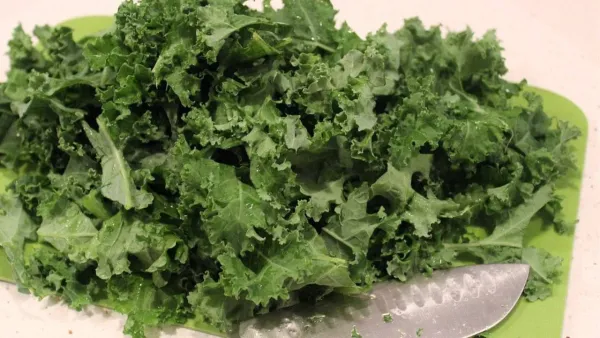
Eating healthy can be difficult. Trends that are driven by online algorithms often focus on Western dietary cultures, and trying to imitate the same in India is often a frustrating experience, as most of the trendy 'health foods' are either expensive, difficult to come by, do not suit the desi palate, or all of the above.
However, what many don't realize is that Indian dietary culture, steeped in the wisdom of Ayurveda and the versatile culture of the land, is rich with superfoods that perform as well, if not much better than their Western counterparts in terms of their price, availability, and health benefits. Here are 5 Indian alternatives to trendy health food that actually pack more punch.
Avocado | Coconut Malai
 Avocado reigns supreme when it comes to international health food. The fruit is a favourite of fitness enthusiasts for its high healthy fat content. However, in India, where avocados do not grow at all, it can be an expensive addition to your diet. But, very few people know that coconut malai has more healthy fats than avocado. Not just that, coconut malai is also metabolized quickly by the body to provide quick energy, has more dietary fibres, almost 3x the iron, making it a better option for preventing anemia and boosting overall blood health.
Matcha Tea | Moringa Powder
Avocado reigns supreme when it comes to international health food. The fruit is a favourite of fitness enthusiasts for its high healthy fat content. However, in India, where avocados do not grow at all, it can be an expensive addition to your diet. But, very few people know that coconut malai has more healthy fats than avocado. Not just that, coconut malai is also metabolized quickly by the body to provide quick energy, has more dietary fibres, almost 3x the iron, making it a better option for preventing anemia and boosting overall blood health.
Matcha Tea | Moringa Powder
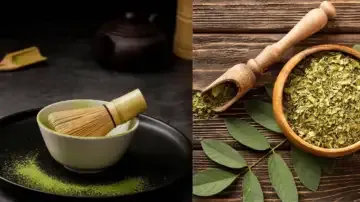 Matcha is everywhere, and most matcha lovers can list the benefits it offers at the drop of a hat. While the magical green drink with an obsessed following is a great source of caffeine and antioxidants, desi moringa powder trumps matcha in terms of protein, vitamins, and minerals, and when it comes to antioxidants, amla or Indian gooseberry is much higher in that when compared to matcha.
Quinoa | Amaranth
Matcha is everywhere, and most matcha lovers can list the benefits it offers at the drop of a hat. While the magical green drink with an obsessed following is a great source of caffeine and antioxidants, desi moringa powder trumps matcha in terms of protein, vitamins, and minerals, and when it comes to antioxidants, amla or Indian gooseberry is much higher in that when compared to matcha.
Quinoa | Amaranth
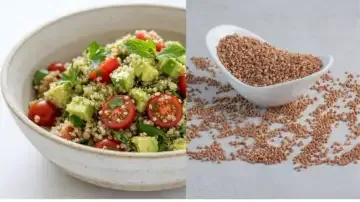 This edible seed plant, which is native to South America, is often used as a rice substitute in Western diets. But you know what has a similar texture and offers many more health benefits? Amaranth or rajgira. This, too, is an edible seed plant that can be used to make staple alternatives. The best part is that it has more protein and mineral content, less sodium, and a lower glycemic index, which helps in diabetes management.
Kale | Spinach
This edible seed plant, which is native to South America, is often used as a rice substitute in Western diets. But you know what has a similar texture and offers many more health benefits? Amaranth or rajgira. This, too, is an edible seed plant that can be used to make staple alternatives. The best part is that it has more protein and mineral content, less sodium, and a lower glycemic index, which helps in diabetes management.
Kale | Spinach
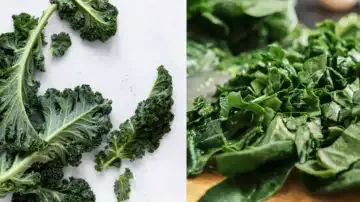 Spinach is nutritionally superior to kale in several ways, offering more protein and dietary fiber, along with significantly higher amounts of folate (vitamin B9), vitamins B2, B5, E, and vitamin A, which support vision and immune health. It also contains greater levels of essential minerals like iron, magnesium, potassium, zinc, and manganese. Additionally, spinach has more eye-protective antioxidants such as lutein and zeaxanthin, and it is lower in calories and sugar, making it a nutrient-dense, versatile leafy green with a milder taste compared to kale.
Chia Seeds | Sabja Seeds
Spinach is nutritionally superior to kale in several ways, offering more protein and dietary fiber, along with significantly higher amounts of folate (vitamin B9), vitamins B2, B5, E, and vitamin A, which support vision and immune health. It also contains greater levels of essential minerals like iron, magnesium, potassium, zinc, and manganese. Additionally, spinach has more eye-protective antioxidants such as lutein and zeaxanthin, and it is lower in calories and sugar, making it a nutrient-dense, versatile leafy green with a milder taste compared to kale.
Chia Seeds | Sabja Seeds
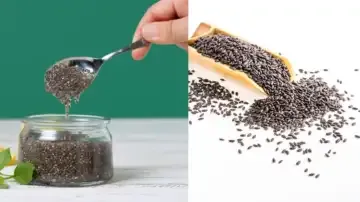 Chia seeds are considered to be a superfood by most health enthusiasts, and rightfully so. It is versatile, offers many health benefits, and is easily available. But when it comes to sabja or sweet basil seeds, they offer the same benefits with the bonus of increased hydration and cooling effect, and are even cheaper than chia seeds.
Chia seeds are considered to be a superfood by most health enthusiasts, and rightfully so. It is versatile, offers many health benefits, and is easily available. But when it comes to sabja or sweet basil seeds, they offer the same benefits with the bonus of increased hydration and cooling effect, and are even cheaper than chia seeds.
 Avocado reigns supreme when it comes to international health food. The fruit is a favourite of fitness enthusiasts for its high healthy fat content. However, in India, where avocados do not grow at all, it can be an expensive addition to your diet. But, very few people know that coconut malai has more healthy fats than avocado. Not just that, coconut malai is also metabolized quickly by the body to provide quick energy, has more dietary fibres, almost 3x the iron, making it a better option for preventing anemia and boosting overall blood health.
Matcha Tea | Moringa Powder
Avocado reigns supreme when it comes to international health food. The fruit is a favourite of fitness enthusiasts for its high healthy fat content. However, in India, where avocados do not grow at all, it can be an expensive addition to your diet. But, very few people know that coconut malai has more healthy fats than avocado. Not just that, coconut malai is also metabolized quickly by the body to provide quick energy, has more dietary fibres, almost 3x the iron, making it a better option for preventing anemia and boosting overall blood health.
Matcha Tea | Moringa Powder
 Matcha is everywhere, and most matcha lovers can list the benefits it offers at the drop of a hat. While the magical green drink with an obsessed following is a great source of caffeine and antioxidants, desi moringa powder trumps matcha in terms of protein, vitamins, and minerals, and when it comes to antioxidants, amla or Indian gooseberry is much higher in that when compared to matcha.
Quinoa | Amaranth
Matcha is everywhere, and most matcha lovers can list the benefits it offers at the drop of a hat. While the magical green drink with an obsessed following is a great source of caffeine and antioxidants, desi moringa powder trumps matcha in terms of protein, vitamins, and minerals, and when it comes to antioxidants, amla or Indian gooseberry is much higher in that when compared to matcha.
Quinoa | Amaranth
 This edible seed plant, which is native to South America, is often used as a rice substitute in Western diets. But you know what has a similar texture and offers many more health benefits? Amaranth or rajgira. This, too, is an edible seed plant that can be used to make staple alternatives. The best part is that it has more protein and mineral content, less sodium, and a lower glycemic index, which helps in diabetes management.
Kale | Spinach
This edible seed plant, which is native to South America, is often used as a rice substitute in Western diets. But you know what has a similar texture and offers many more health benefits? Amaranth or rajgira. This, too, is an edible seed plant that can be used to make staple alternatives. The best part is that it has more protein and mineral content, less sodium, and a lower glycemic index, which helps in diabetes management.
Kale | Spinach
 Spinach is nutritionally superior to kale in several ways, offering more protein and dietary fiber, along with significantly higher amounts of folate (vitamin B9), vitamins B2, B5, E, and vitamin A, which support vision and immune health. It also contains greater levels of essential minerals like iron, magnesium, potassium, zinc, and manganese. Additionally, spinach has more eye-protective antioxidants such as lutein and zeaxanthin, and it is lower in calories and sugar, making it a nutrient-dense, versatile leafy green with a milder taste compared to kale.
Chia Seeds | Sabja Seeds
Spinach is nutritionally superior to kale in several ways, offering more protein and dietary fiber, along with significantly higher amounts of folate (vitamin B9), vitamins B2, B5, E, and vitamin A, which support vision and immune health. It also contains greater levels of essential minerals like iron, magnesium, potassium, zinc, and manganese. Additionally, spinach has more eye-protective antioxidants such as lutein and zeaxanthin, and it is lower in calories and sugar, making it a nutrient-dense, versatile leafy green with a milder taste compared to kale.
Chia Seeds | Sabja Seeds
 Chia seeds are considered to be a superfood by most health enthusiasts, and rightfully so. It is versatile, offers many health benefits, and is easily available. But when it comes to sabja or sweet basil seeds, they offer the same benefits with the bonus of increased hydration and cooling effect, and are even cheaper than chia seeds.
Chia seeds are considered to be a superfood by most health enthusiasts, and rightfully so. It is versatile, offers many health benefits, and is easily available. But when it comes to sabja or sweet basil seeds, they offer the same benefits with the bonus of increased hydration and cooling effect, and are even cheaper than chia seeds.
READ NEXT
-
Gardeners urged to complete one task with fallen leaves this autumn

-
Gardeners urged to complete one task with fallen leaves this autumn

-
Gardeners urged to sow these flowers in September for 'gorgeous' autumn display

-
Volodymyr Zelensky issues major update after top Ukrainian politician shot dead

-
U Mumba and Bengal Warriorz Shine in PKL 2025 Action
